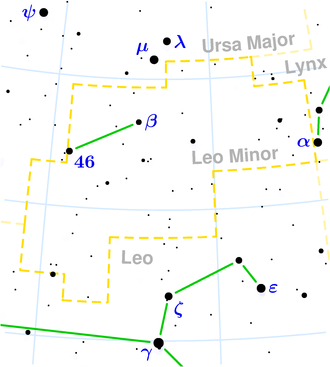IC 2591
| Galaxie IC 2591 | |
|---|---|
 | |
| IC 2591[1], SDSS-Aufnahme | |
| AladinLite | |
| Sternbild | Kleiner Löwe |
| Position Äquinoktium: J2000.0, Epoche: J2000.0 | |
| Rektaszension | 10h 36m 38,667s[2] |
| Deklination | +35° 03′ 10,48″[2] |
| Erscheinungsbild | |
| Morphologischer Typ | Sbc / HII[2] |
| Helligkeit (visuell) | 14,0 mag[3] |
| Helligkeit (B-Band) | 14,7 mag[3] |
| Winkelausdehnung | 1,20' × 0,7'[3] |
| Positionswinkel | 128°[3] |
| Flächenhelligkeit | 13,7 mag/arcmin²[3] |
| Physikalische Daten | |
| Rotverschiebung | 0.022672 ± 0.000033[2] |
| Radialgeschwindigkeit | 6797 ± 10 km/s[2] |
| Hubbledistanz vrad / H0 | (303 ± 21) · 106 Lj (92,9 ± 6,5) Mpc [2] |
| Geschichte | |
| Entdeckung | Stéphane Javelle |
| Entdeckungsdatum | 14. Mai 1903 |
| Katalogbezeichnungen | |
| IC 2591 • UGC 5763 • PGC 31474 • CGCG 183-031 • MCG +06-23-022 • IRAS 10337+3518 • KUG 1033+353 • 2MASX J10363862+3503109 • NVSS J103638+350310 • WISEA J103638.65+350310.5 | |
IC 2591 ist eine Balken-Spiralgalaxie vom Hubble-Typ SBc[3] mit ausgedehnten Sternentstehungsgebieten im Sternbild Kleiner Löwe am Nordsternhimmel. Sie ist schätzungsweise 303 Millionen Lichtjahre von der Milchstraße entfernt und hat einen Durchmesser von etwa 105.000 Lichtjahren.
Das Objekt wurde am 14. Mai 1903 von Stéphane Javelle entdeckt.[4]
Weblinks
Einzelnachweise
Auf dieser Seite verwendete Medien
Autor/Urheber: Sloan Digital Sky Survey, Lizenz: CC BY 4.0
The sky image is obtained by Sloan Digital Sky Survey, DR14 with SciServer.
Angle of view: 4' × 4' (0.3" per pixel), north is up.
Details on the image processing pipeline: https://www.sdss.org/dr14/imaging/jpg-images-on-skyserver/Autor/Urheber: Torsten Bronger, Lizenz: CC-BY-SA-3.0
This is a celestial map of the constellation Leo Minor, the Small Lion.




